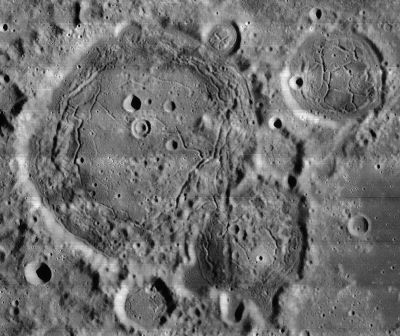Lavoisier
Contents
Lavoisier - and concentric crater N°48 on its floor
|
Lat: 38.2°N, Long: 81.2°W, Diam: 70 km, Depth: 0.77 km, Rükl 8 |
Table of Contents
[#Lavoisier - and concentric crater N°48 on its floor Lavoisier - and concentric crater N°48 on its floor]
[#Lavoisier - and concentric crater N°48 on its floor-Images Images]
[#Lavoisier - and concentric crater N°48 on its floor-Maps Maps]
[#Lavoisier - and concentric crater N°48 on its floor-Description Description]
[#Lavoisier - and concentric crater N°48 on its floor-Description: Elger Description: Elger]
[#Lavoisier - and concentric crater N°48 on its floor-Description: Wikipedia Description: Wikipedia]
[#Lavoisier - and concentric crater N°48 on its floor-Additional Information Additional Information]
[#Lavoisier - and concentric crater N°48 on its floor-Nomenclature Nomenclature]
[#Lavoisier - and concentric crater N°48 on its floor-LPOD Articles LPOD Articles]
[#Lavoisier - and concentric crater N°48 on its floor-Bibliography Bibliography]

Lunar Orbiter IV image 4189 H2 Lavoisier is the large feature mostly to the left of center. The floor fractured crater in the upper right is Lavoisier H, while the irregularly shaped on with the mounded floor is Lavoisier F. The pentagonal crater tangent to the south rim of Lavoisier is Lavoisier W.
Images
LPOD Photo Gallery Lunar Orbiter Images Kaguya HDTV
- The LPI's Hi-Res scan of Lunar Orbiter 4's photograph LOIV-189-H2 shows Lavoisier near the frame's lower margin, with C.A.Wood's 48th Concentric Crater (the 48th item in his list of 1978) on Lavoisier's floor.
- Lunar Orbiter 4's photograph LOIV-183-H2 (immediately east of the above mentioned LOIV-189-h2), shows Concentric Crater N°45, west of Lavoisier A, located on a small system of low ridge-like hills.
- Research: Danny Caes
Maps
(LAC zone 22D1) USGS Digital Atlas PDF
Description
This Lunar Orbiter IV image reveals a wide wreath of rilles and churned up rocks that is more intense than others of the lunar nearside. The nearby crater Lavoisier F (bottom right) is somewhat similar (and has a domed floor and a string of secondary craters that don’t seem to come from Orientale). Lavoisier and a number of other rille-cut craters along this marshy western margin of Oceanus Procellarum are floor-fractured craters. Remember that FFC are normal impact craters deformed by the rise of magma under them, leading to uplifted floors, rilles, and various other aspects of volcanism. And like the opposite limb FFC Humboldt, Lavoisier has dark pyroclastic deposits and a concentric crater. The pyroclastic (ashy) material must have erupted from the rilles but there are no conspicuous dark halo craters as at the FFC Atlas and Alphonsus. Notice the very narrow mare ridge-like feature along the southwest (bottom left) edge of Lavoisier F and in some places in Lavoisier. In the case of F this ridge was probably produced by the thrusting of one peice of the crater’s floor over an adjacent piece due to the uplift of the crater center. From LPOD Aug 12, 2006.
Description: Elger
(IAU Directions) LAVOISIER.--A small bright walled-plain N. of Ulugh Beigh. It has a somewhat dark interior. East of it is Lavoisier A, a ring-plain about 14 miles in diameter. Both are too near the limb for useful observation.
Description: Wikipedia
Additional Information
- Depth data from Kurt Fisher database
- Westfall, 2000: 0.77 km
- Viscardy, 1985: 2 km
- Cherrington, 1969: 2.19 km
- Elger's description does not apply to Lavoisier as it is today. Was he wrong, or has the designation been moved?
- Nearby concentric crater (N°48 in C.A.Wood's list of Concentric Craters, 1978, is the one on the floor of Lavoisier) (N°45 is the one west of Lavoisier A).
- Lavoisier itself is a wonderful floor-fractured crater - tychocrater tychocrater Sep 9, 2007
- Lavoisier A
- Lavoisier A, a crater in Oceanus Procellarum (east-southeast of Lavoisier itself), looks remarkably "dish shaped" when the morning terminator runs at about 75 degrees West (after local sunrise). During this phase, Lavoisier A is a most interesting telescopic object!- DannyCaes DannyCaes Sep 22, 2008
- Central peak height
- Sekiguchi, 1972: <0.7 km "A low mound on the easterly eccentric position" - fatastronomer fatastronomer
- Lavoisier D (now known as Von Braun)
- Central peak heights
- Sekiguchi, 1972: <0.5 km
- Sekiguchi, 1972: <1 km "A small peak at the bottom of the south-east wall" - fatastronomer fatastronomer
- Central peak heights
- Lavoisier E
- Central peak height
- Sekiguchi, 1972: 0.7 km "A low central hill"
- Sekiguchi, 1972: 0.3 km "A hill at the bottom of the north-west wall" - fatastronomer fatastronomer
- Central peak height
- Lavoisier C and Lavoisier T, a couple of odd craters southeast of Lavoisier itself (at the border of Oceanus Procellarum) show a curious "double rim" tendency. See the upper section of LO-IV-183-h1. - DannyCaes DannyCaes Aug 6, 2014
Nomenclature
Named for Antoine-Laurent de Lavoisier (August 26, 1743 – May 8, 1794), the "father of modern chemistry", prominent in the histories of chemistry, finance, biology, and economics. He stated the first version of the law of conservation of mass, co-discovered, recognized and named oxygen (1778), as well as hydrogen, introduced the metric system and wrote the first extensive list of elements.
Rimae Lavoisier (an unofficial name from D.Caes for the system of rilles on the floor of Lavoisier).
LPOD Articles
Bibliography
This page has been edited 1 times. The last modification was made by - tychocrater tychocrater on Jun 13, 2009 3:24 pm - afx3u2